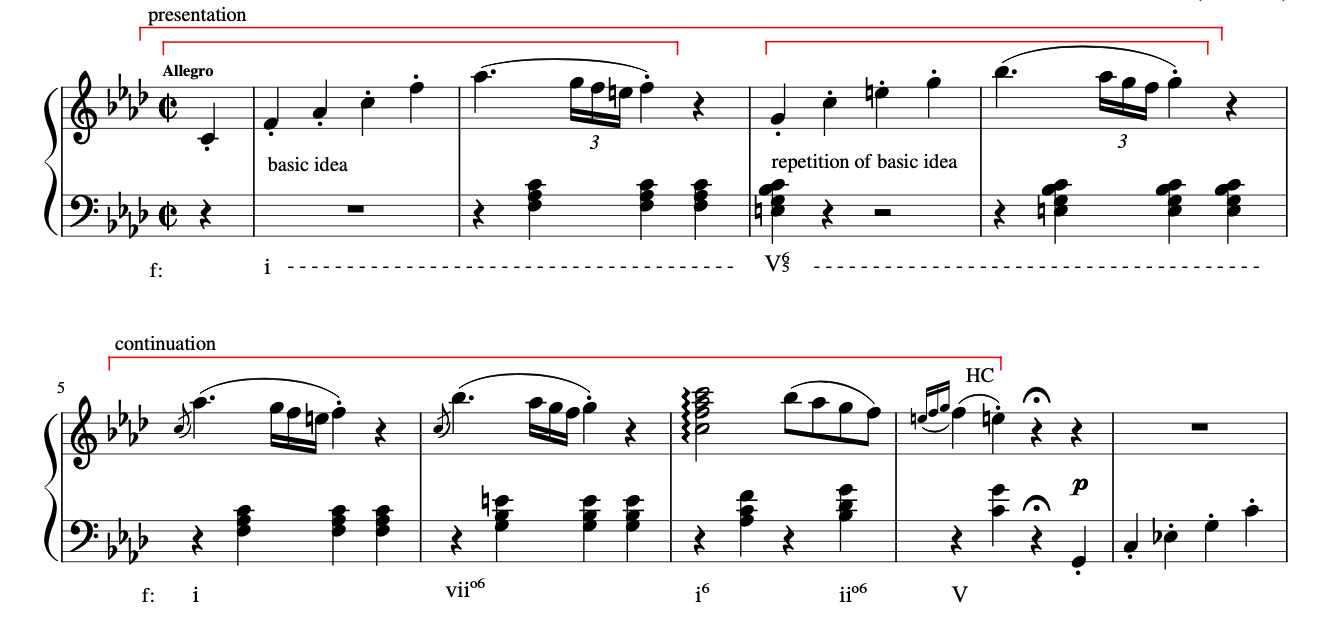
A brief introduction to the concept of Sentence
Last updated on September 11th, 2023 at 11:32 pm
As Schönberg stated in his book on musical composition, a piece of music is organized some way or the other to make it intelligible or comprehensible.[1]Arnold Schönberg, Gerald Strang, and Leonard Stein. Fundamentals of Musical Composition (London: Faber and Faber, 1967), 1 and 21. See also my post Books by Schönberg and Ratz. One way to achieve this is to present the musical ideas in a structured way. In tonal music (also called the common-practice period [ca.1650- ca.1900]) this is called form.
The two most elementary forms to present a musical idea or theme are the sentence and the period. Both deal with the repetition of a so called basic (musical) idea. The repetition is a manner to improve the comprehensibility (getting familiar with the musical idea). Each of these concepts deal with repetition in a different way.
This post is about the sentence. The post about the period can be found here.
I find the introduction of Steven Laitz to the concept of sentence very appealing. It goes as follows (a parent calling her/his child to come in):
“Johnny, it’s time to come in now.”
“Johnny, you need to come in now.”
“Johnny, I mean it. Get in here right now or you’ll be grounded for life.”[2]Steven G. Laitz, The Complete Musician: An Integrated Approach to Theory, Analysis and Listening (4th Ed (New York [etc.]: Oxford University Press, 2016), 393.
As Laitz explains, the first two statements are equal in length (both eight syllables) and the message is the same, although with a slight variation. The third phrase is exactly twice as long (sixteen syllables) and the message is invigorated by the threat of the parent. You can imagine that the tone of voice is different also.
Now when this kind of coherent utterance consisting of a statement, its repetition and then a more elaborated extension in the proportion 1:1:2 is used in music, it is called a sentence structure or sentence. The “default” length in measures is 2-2-4.
Perhaps the most famous example of a sentence is the opening of Beethoven’s piano sonata in f minor, op. 2. no. 1.[3]It is used as an example in: Schönberg, Fundamentals of Musical Composition; Laitz, The Complete Musician and William E. Caplin, Classical Form: A Theory of Formal Functions for the Instrumental Music of Haydn, Mozart and Beethoven (New York [ect.]: Oxford University Press, 1998). Here it is:

This is a sentence with a 2+2+4 structure. Measures 1-2 state a musical idea which is repeated in mm.3-4. This entity of four bars is called the presentation of the sentence.
The first statement (mm.1-2) is called the basic idea. The repetition in mm.3-4 is simply called the repetition of the basic idea. In this case it is not in the tonic (f minor) but in the dominant (harmonized with a C dominant seventh chord in first inversion, V65). This kind of statement of a basic idea with its repetition in the dominant is called a statement-response presentation.
The next four measures (mm.5-8) are called the continuation. Just a few remarks about this phrase. First of all notice that m.5 and m.6 each contain only the second half of the basic idea. These are fragments of the basic idea and therefore this is called fragmentation.
Measures 7 and 8 contain even less characteristics of the basic idea and lead in fact to the half cadence (HC) in m.8. The process of leaving out more and more characteristics of the basic idea is called liquidation. It creates room for the cadential progression.
Caplin distinguishes various functions in the parts of a sentence. Measures 7-8 have the cadential function and therefore are sometimes called the cadential.[4]Caplin, Classical Form, 11.
The last remark to be made in this short introduction is about the harmonic rhythm. As can be seen in the diagram below the first four measures have a harmonic rhythm that changes every two bars. In the continuation however the harmonic rhythm accelerates: first per measure and then (in m.7) per half measure. One could say that in the presentation of the sentence the emphasis is on the motive/thematic aspects and in the continuation the emphasis shifts to the harmonic progression to give a feeling of rounding off and arrival (in this case open ended because of the half cadence).
The first sentence of the Beethoven sonata can be represented in a diagram as follows:

Notes
| ↩1 | Arnold Schönberg, Gerald Strang, and Leonard Stein. Fundamentals of Musical Composition (London: Faber and Faber, 1967), 1 and 21. |
|---|---|
| ↩2 | Steven G. Laitz, The Complete Musician: An Integrated Approach to Theory, Analysis and Listening (4th Ed (New York [etc.]: Oxford University Press, 2016), 393. |
| ↩3 | It is used as an example in: Schönberg, Fundamentals of Musical Composition; Laitz, The Complete Musician and William E. Caplin, Classical Form: A Theory of Formal Functions for the Instrumental Music of Haydn, Mozart and Beethoven (New York [ect.]: Oxford University Press, 1998). |
| ↩4 | Caplin, Classical Form, 11. |
Recent Comments